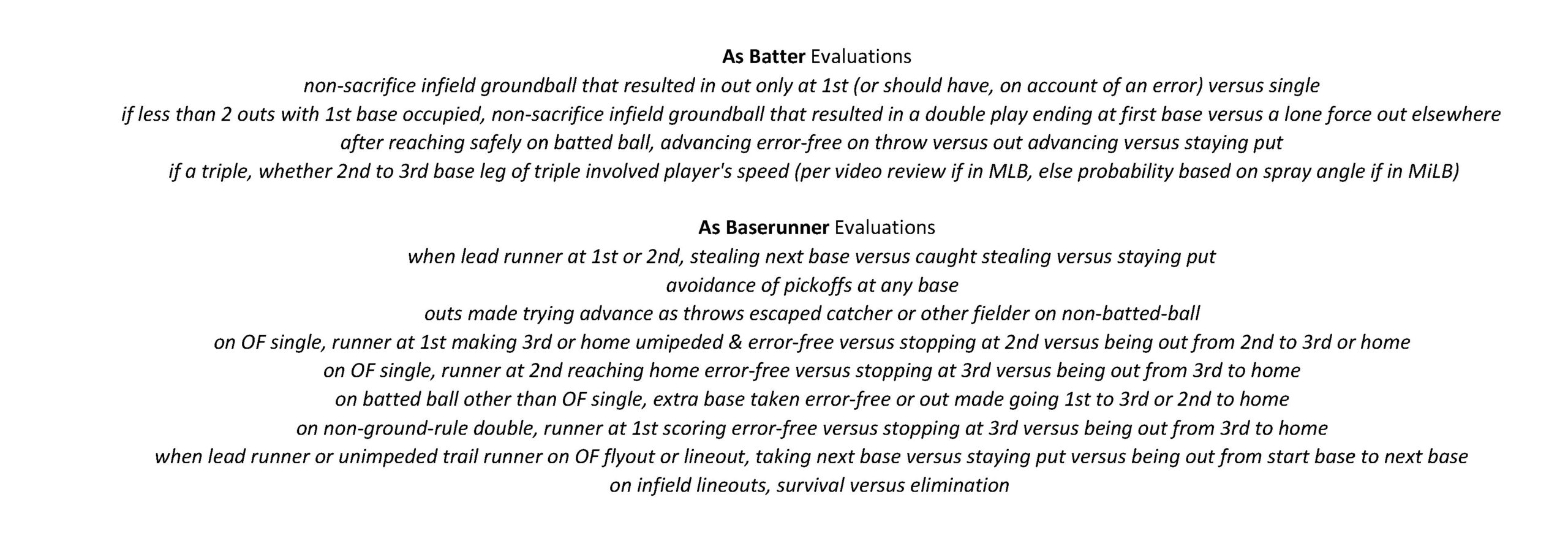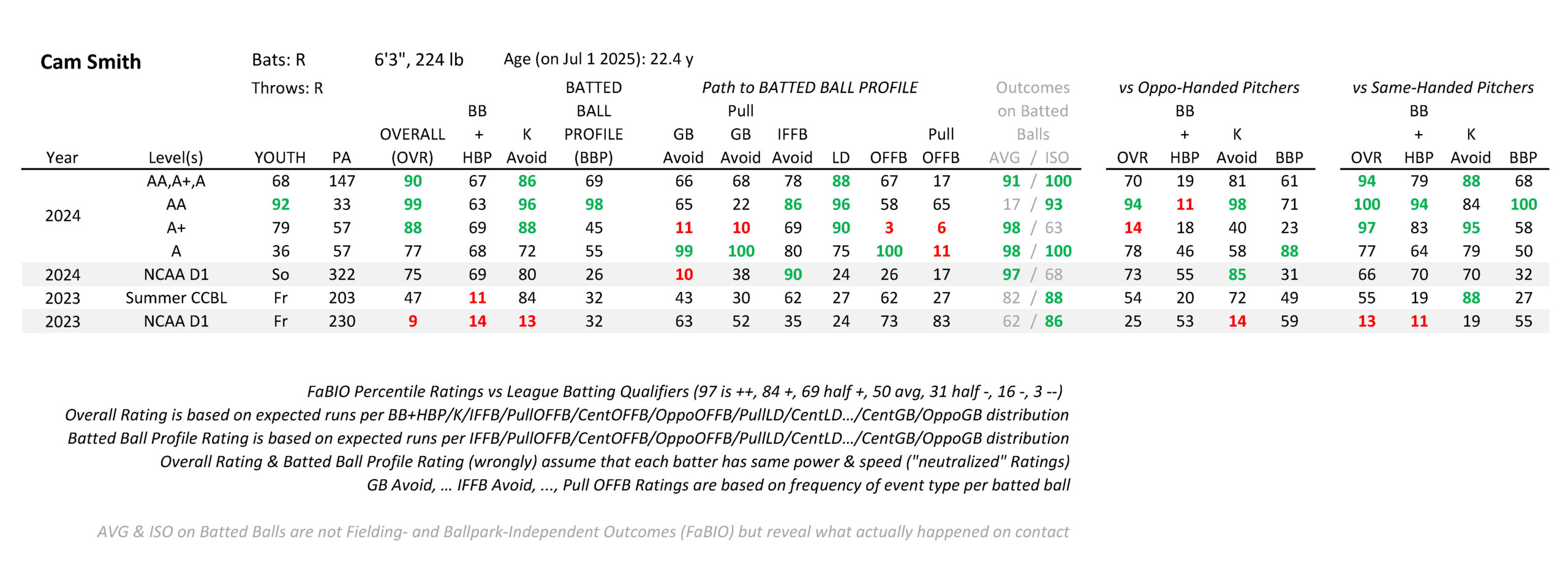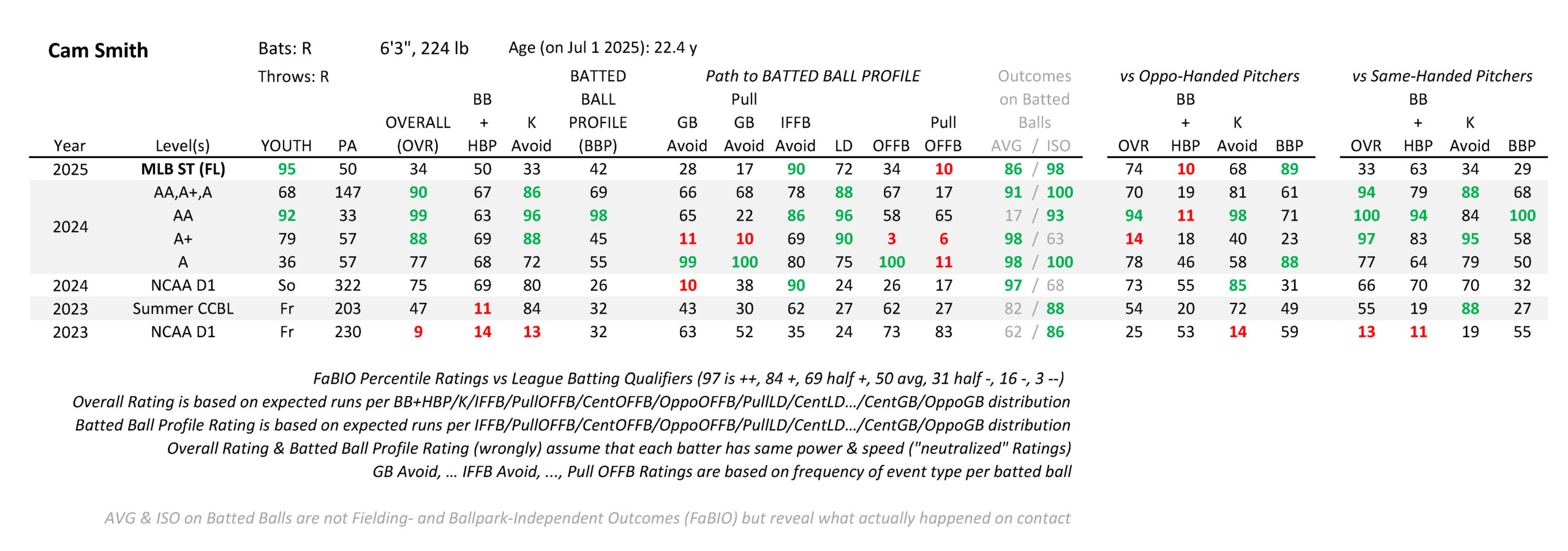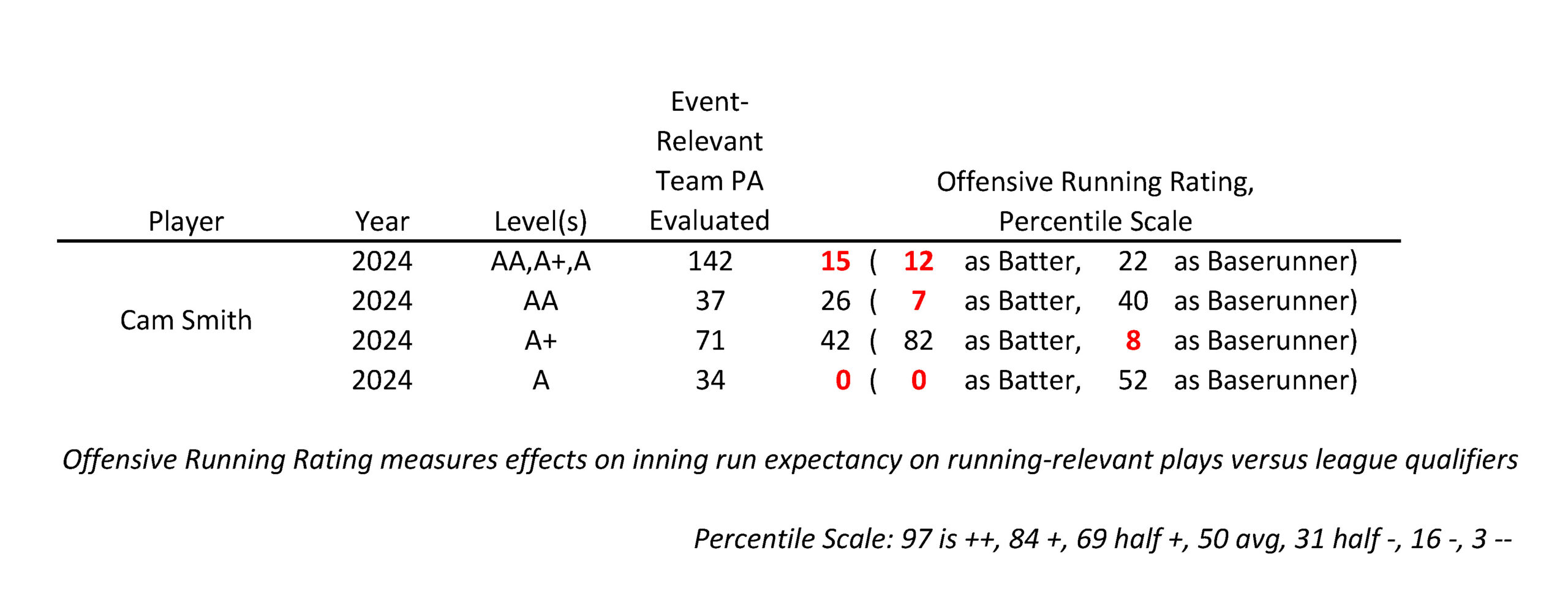
Cam Smith's fantasy baseball prospect outlook, sleeper potential for dynasty leagues. Matt uses his custom suite of fundamentals-rooted evaluation tools.
On the eve of the 2024 MLB Draft, Cam Smith seemed to be a draft-eligible sophomore needing a major league batted ball profile makeover.
How did his plate profile evolve from 2023 Florida State freshman to 2024 Cubs minor leaguer to 2025 Astros MLB spring training non-roster invitee?
What must he do to survive as an unforeseen 2025 major leaguer and avoid being optioned to a minor league affiliate of a farm system he has yet to play a game for? Let's evaluate Smith and find out.
Be sure to check all of our fantasy baseball lineup tools and resources:- Fantasy baseball trade analyzer
- BvP matchups data (Batter vs. Pitcher)
- PvB matchups data (Pitcher vs. Batter)
- Who should I start? Fantasy baseball comparisons
- Daily MLB starting lineups
- Fantasy baseball closer depth charts
- Fantasy Baseball live scoreboard
- Fantasy baseball injury reports
Brief Explanation of the FaBIO Model
My Fielding- and Ballpark-Independent Outcomes (FaBIO) evaluation model sorts every plate appearance into one of 12 outcome bins (BB+HBP, K, IFFB, Pull-Third OFFB, Center-Third OFFB, Oppo-Third OFFB, Pull-Third LD, Center-Third LD, Oppo-Third LD, Pull-Third GB, Center-Third GB, Oppo-Third GB) and charges the pitcher and batter with their league's mean runs value for said particular event that season.
Dividing a batter's total number of expected runs by plate appearance (PA) yields expected runs per PA that can be percentile ranked relative to the league mean and standard deviation for that parameter amongst league batter qualifiers to arrive at their Overall Rating.
Its three subcomponents of BB+HBP Rating (based on BB+HBP per PA), Strikeout Avoid Rating (K Avoid, based on K per PA), and Batted Ball Profile Rating (expected runs per batted ball) are also reported to identify the path the batter traveled to reach their Overall Rating.
Overall Rating and Batted Ball Profile Rating of batters should be considered power- and speed-neutralized metrics since the real-world runs value of a single batter's typical OFFB or LD varies with their strength, and the expected runs value of their typical GB varies with their speed.
To better understand the Path to Batted Ball Profile, we will also examine percentile ratings for select batted ball event types (on a per-batted ball basis). To check how well expected batted ball outcomes match real-world ones, we will compute percentile ratings for hits (AVG) and isolated power (ISO, or simply extra bases) on batted balls (recognizing full well that these two parameters are neither fielding- nor ballpark-independent outcomes).
What most explains a batter's ability to generate hits (AVG) on batted balls is any LD, IFFB avoidance, Pull-Third OFFB, and Pull-Third GB avoidance. What most explains their ability to generate extra bases (ISO) on batted balls is any OFFB, Pull-Third OFFB, Pull-Third LD, and IFFB avoidance.
A percentile rating of 97 amounts to plus-plus (two standard deviations above the mean), 84 is plus (one standard deviation above the mean), 69 is half plus, 50 is average, 31 is half minus, 16 is minus, and three is minus-minus.
A new addition to this suite of evaluation models is the Offensive Running Rating. This tool quantifies how each relevant inning's run expectancy was impacted by the player's action or inaction as either a batter or baserunner on very specific types of plays that are more likely to involve one or both of their speed or offensive running technique, plus acumen.
The evaluated batter and baserunner events are summarized in the graphic.
Prospect Analysis: Cam Smith
Evolution of College Plate Profile
In a larger sample of 230 PA as a 2023 Florida State freshman, Cam Smith managed only 14 BB+HBP and 13 K Avoid Ratings. The best feature of a half plus 32 Batted Ball Profile was an almost plus (83) Pull OFFB Rating that helped pave the way to plus (86) ISO production. Otherwise, he produced hits somewhat frequently (62 AVG) for such a low LD + IFFB Avoid + Pull GB Avoid hit trio.
A 203 PA stint in Cape Cod Baseball League that summer featured a whopping two standard deviation improvement versus D1 in K Avoid (from minus to plus), while else BB+HBP and Batted Ball Profile stayed similar in magnitude though Pull OFFB sank 1.5 standard deviations. Smith showed well above average physicality in producing circa plus AVG and ISO on Batted Balls despite fewer LD and Pull OFFB.
Those summer K Avoid gains largely held through 2024 sophomore season as BB+HBP rose 1.5 standard deviations to a 69 mark. Batted Ball Profile dropped six percentile points as the summer 2023 trend of loft (per GB Avoid, OFFB) falling, IFFB rising, and Pull OFFB dropping spilled over into 2024. This time around, Smith produced an extreme amount of AVG for a hit trio that skewed all IFFB Avoid and relatively high ISO (68) per the (26) OFFB and (17) Pull OFFB Ratings.
Batted ball profile launch and spray fundamentals were in clear need of refinement after two fuller D1 seasons sandwiched around a large-sample Cape summer. Factor in that his squad’s 2024 NCAA postseason run to Omaha would have very limited any wood bat summer play and the sophomore may have been fortunate to be draftable via age criteria. A third D1 season might have seen his batted ball profile drift still further into a state of disrepair, beyond which it might never fully recover.
With the 14th selection of the 2024 MLB Draft in their possession, the Cubs liked the state of the non-batted-ball outcomes after two D1 seasons and Smith’s transference of a prototype pro physique into rather physical batted-ball outcomes. They rolled the dice on that Smith remained malleable enough to refine the swing and approach in ways that would make the batted ball profile better align with plus or better hits and extra bases production. Smith agreed to sign from that slot with the Cubs at a $5.07 million bonus.
Evolution of Pro Plate Profile
While evaluating Cam Smith before the Draft, I could imagine the recent sophomore spending extended time with hitting instructors at the future employer’s training complex and perhaps not being assigned to an affiliate until the final weeks of the low-A season.
Instead, he joined that low A Cubs squad on August 9 and put up a 75 LD/80 IFFB Avoid/100 Pull GB Avoid hit trio over 57 PA that blew away the priors while hitting many an OFFB but rarely a Pull OFFB. Those OFFB evaporated more fully over the next 57 PA in High-A, though LD ticked up still more, as did K Avoid, despite the relative increase in competition level. A 33 PA finale in AA brought another increase in LD and K Avoid while OFFB and the still rarer for him Pull OFFB claimed a seat at the batted ball profile table.
A 67 BB+HBP/86 K Avoid/69 Batted Ball Profile line compiled over the three pro levels mirrored the 2024 D1 line in the first two non-batted-ball outcome dimensions and reflected a 1.5 standard deviation improvement in batted ball profile fundamentals. Such can only be considered a major victory for the Cubs' amateur scouting department and player development staff.
Smith’s impressive half-year tenure with the Cubs would end during the winter. This was when the organization traded him to the Astros as part of their three-player package to acquire the final year of the contract of pending free agent outfielder Kyle Tucker.
Smith attended Astros MLB spring camp via a non-roster invite. He played sporadically in the first two weeks but produced some loud contact, including homers that disproportionately went to the center, opposite third of the outfield (Pull OFFB Rating was only 10). The hit trio then rather resembled the 2024 A+ and AA ones, as LD and IFFB were up while Pull GB Avoid was down. K Avoid registered only 33, or 1.5 standard deviations lower than the 86 he had earned across the three Cubs MiLB affiliates.
As other camp candidates for Tucker’s vacated corner right field spot played their way out of the picture, Astros planted Smith there and considered whether he might be their best option. After a run of everyday play, Smith was made the Opening Day roster as the Astros' primary rightfielder, even with what register on these scales as fringier non-batted-ball and all-around batted ball profile fundamentals.
Evolution of Pro Offensive Running
Cam Smith posts circa 90th percentile sprint speeds by 2025 MLBer standards at age 21 despite a larger 6-foot-3, 224-pound frame. Yet, offensive running remains an underdeveloped area of the game with this historically middle of the order batter for whom hitting has long been priority one.
The first 2024 sets of pro Offensive Running Ratings peg Smith only in the range of half to full minus at this fundamental.
Dynasty Fantasy Baseball Focus
Smith made big gains in the primary core hitting fundamental of line drive generation as a 2024 MiLBer, and that improvement carried over fairly well to MLB spring games. Two key defects that remain in the work-in-progress batted ball profile are a shortage of pull-third outfield flyballs and the overabundance of pull-third groundballs. In short, his launch angles are too low on pulls.
Spring game outcomes strongly hint that Smith will endure many more strikeouts while cutting MLB teeth in earlier 2025 months relative to his prior MiLB stints. A corresponding decline in batted balls per plate appearance will then elevate the need to run a relative surplus on line drives to keep batting averages passable to better.
Smith has done much of his extra bases damage to the center-third of the field to this point of his college and pro career. That bias, including a relative shortage of aerial pulls, would have played better in his former future MLB home park of Wrigley Park than it will in his present home park. As the Houston park plays short to the pull and opposite thirds but deep to the center one, expect Smith to produce relatively more doubles plus stray triples than home runs during 2025 and likely also 2026 MLB play.
In earlier 2025 MLB, Smith must hit line drives else return to AAA more likely than AA to re-find that essential element of his present plate profile. Anything resembling a fuller 2025 MLB campaign with roughly average offensive production would be considered a fantastic first step in the direction of a potential 2026 or 2027 breakout.
At maturity, anticipate a batting average that registers a few to several ticks above the league mean, an extra-base-hit mix that prominently features doubles with half to perhaps full plus homers, and quite good non-batted-ball outcomes. The now plus sprinter would be unlikely per his present and future physique to post double-digit steals annually, but as pro experience is gained and hitting becomes less of an area of focus, Smith could register as an average offensive runner on an all-around basis.
Dynasty fantasy owners should root for positional eligibility at all four corner spots, in the style of Kris Bryant.
Download Our Free News & Alerts Mobile App
Like what you see? Download our updated fantasy baseball app for iPhone and Android with 24x7 player news, injury alerts, sleepers, prospects & more. All free!

More Fantasy Baseball Advice
 RADIO
RADIO




























